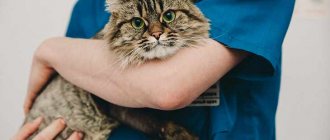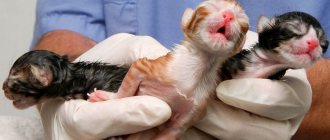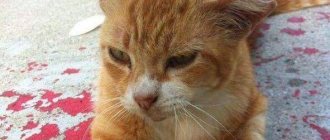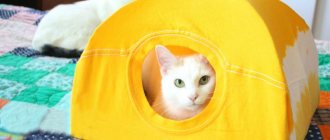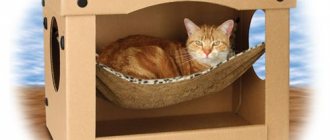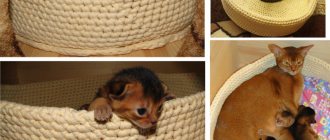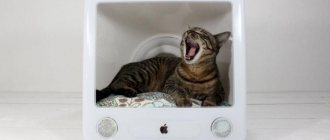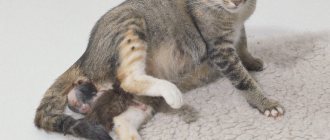It is necessary to prepare the place for the cat's birth in advance, preferably 2 weeks before the birth. This will provide comfortable conditions for the animal and protect future offspring. The maternity house can be purchased ready-made or made with your own hands. To equip and decorate such a home, you need a small amount of materials and basic skills in working with tools. The main thing is to take into account the size of the cat and leave room for offspring.
Possible complications during lambing
Complications during lambing can occur at any stage of birth in both mother and kittens.
Complications from the parturient side may be the following:
- ruptures of the birth canal due to hypertension;
- bleeding;
- refusal of kittens - the cat is not interested in newborns and growls if they are placed near her;
- sepsis;
- uterine prolapse;
- retention of placenta;
- acute mastitis – inflammation of the mammary glands;
- cannibalism.
Newborn problems:
- congenital malformations - cleft palate, development of internal organs outside the body;
- intrauterine infections, due to which kittens are stillborn or die in the first few days;
- abnormal position of the fetus - in such cases the cat will not be able to give birth on its own;
- aspiration (inhalation) of amniotic fluid, pneumonia.
Cleft palate in a kitten
How you can help:
- Before mating a cat, it is necessary to thoroughly examine her and the future father of the kittens for the presence of infections and pathologies that are transmitted genetically.
- During pregnancy, transfer the cat to specialized food for pregnant and lactating cats.
- Take an x-ray a week before the expected birth - this way you can accurately find out the number of kittens in order to understand when the birth should end. It is impossible to determine their number by ultrasound.
- Create the most sterile conditions for childbirth.
- Find “your” veterinarian and enlist his support.
A breed such as the Scottish has two variants of the phenotype - fold-eared and straight-eared. And it requires a special approach when breeding.
It is very important that only one of the parents has lop ears. If you cross two fold cats, then 100% of the kittens will be born with joint pathologies and will hardly live to be three years old
These will be disabled animals. This disease is called osteochondroplasia of Scottish fold cats and is associated with a mutation of cartilage tissue.
Routine ultrasound during pregnancy
A specialist can prescribe an ultrasound scan at almost any time during pregnancy if the animal’s condition is in doubt. In the early stages, the owner can contact the veterinarian to confirm or deny the presence of pregnancy.
Next, the development of the fetus is monitored and the number of future kittens is determined. In any case, a visit to the veterinary clinic is recommended both for preventive purposes and if you experience feelings of anxiety about the condition of your pet.
Scheduled ultrasound
Possible complications after childbirth
Childbirth in a cat does not always go smoothly. Sometimes complications occur, some of which can even threaten the pet’s life. The owner must recognize them in time and try to eliminate the consequences.
Dead kitten
The causes of stillbirth in a cat can be either intrauterine death or death from asphyxia during passage through the birth canal. If a kitten is born without signs of life (does not move, does not squeak for 10–15 minutes), then it should be removed from the cat and other healthy kittens.
I just had a situation where a kitten got stuck in the birth canal and died. We were at work all day and that's when the cat started giving birth. When we returned, at first we didn’t suspect anything. But the cat had some kind of dense lump sticking out under its tail. After about twenty minutes we realized that not everything was going smoothly. My husband got down to business, he performed some manipulations, and the lump was born, but, unfortunately, already lifeless. Fortunately, the next two babies were born without problems.
The kitten can't get out
If the kitten cannot pass through the birth canal and is stuck there, then the cat must be injected with 0.2 mg of oxytocin. When the medicine does not work and the situation is not resolved, it is necessary to urgently contact a veterinarian to solve the problem surgically. It is unacceptable to pull a kitten yourself - this can cause harm not only to the baby, but also to the cat.
The kitten got out, but there is a bubble sticking out
The cat can cope with this problem on its own, however, in the event of a difficult birth, if the animal is too tired, veterinary care may be required, the absence of which is fraught with dangerous consequences.
What should you always have on hand?
Be sure to prepare all of the following and have all of these things on hand at all times. Remember, you most likely won't have to interfere with the birth process, but if necessary, don't run around the house in a panic. Read about the main problems that some cat owners face, and immediately write down the number of a 24-hour veterinary hospital.
So here's what you should prepare:
- Stock up on paper towels and clean cloths. We highly recommend using cotton or flannel scraps, as newborn kittens hardly get tangled in them. Never put cotton wool or “loose” fabrics in the basket, in which the claws of newborn pets will get stuck. Old onesies and children's shirts are ideal (including as a filler for a basket).
- Notepad and pen. We strongly advise you to record the time of birth of each kitten and record when the placenta is delivered after each baby. In addition, you can also record the cat’s body temperature (if you measure it). In the same notebook, write down the number (or preferably several) of the veterinarian.
- Antiseptic solution. It is easy to make it yourself by preparing a 70% aqueous solution of alcohol. However, alcohol tincture of iodine, vodka or even cologne will work perfectly (but it is not advisable to use it).
- Gauze bandages.
- Unwaxed dental floss.
- Disposable gloves for caring for newborn kittens.
- If your cat has had any problems breastfeeding in the past, be sure to prepare a special formula for newborn kittens, as well as a bottle. Luckily, you probably won't have to use this, but it still wouldn't hurt to have some extra. In any case, you can feed the mixture to older kittens (as complementary food).
- Suture removal kit , including blunt scissors and forceps. You may need all this if you have to tie the umbilical cord yourself.
- Accurate scales for weighing small kittens. They are extremely useful if you doubt the viability of the newborn babies.
Alarming symptoms
An unqualified owner cannot always help a furry pet. That is why during childbirth you should have the telephone number of the treating veterinarian, or preferably two or three numbers, at hand. Four symptoms are a serious reason to contact a specialist.
Ahead of schedule. Most often, premature birth occurs in a cat due to a frozen pregnancy, non-viability of the offspring, placental abruption, or injury. The stages of labor pass faster already on the 50-55th day, sometimes earlier. Most often, a cat gives birth to dead kittens. The living premature offspring dies in the coming days. It happens that a cat gives birth to just one dead baby prematurely. The rest emerge alive and healthy on time. If your cat gives birth prematurely, have her examined by a specialist to understand further steps. Lack of childbirth. If the pet does not give birth for more than 70 days and if this is not a false “birth” due to an imaginary pregnancy in the cat, then the pregnancy is probably frozen. The cubs most likely died, so it is urgent to save the pet from possible infections and damage to the uterus. Missed birth
It is important to determine when labor is truly over. If the pushing has stopped and the cat is resting, this does not guarantee that all the kittens will come out.
You should observe your mother's behavior. A cat that has not yet given birth reluctantly takes care of the cubs, does not leave the “nest” and does not change position, refuses to drink, and periodically strains. To make sure, you can feel the stomach three to four hours after birth. The elasticity and tension of the muscles indicate that there is still a kitten left in the womb. Discharge. Any colored, pungent-smelling discharge during pregnancy and childbirth is a deviation from the norm. During strong, long contractions (more than an hour) without subsequent labor, blood may flow profusely. In this case, it is also necessary to show the cat to a specialist.
Fetal pathologies do not always depend on the health of the mother and can be inherited from the father. However, the physical and mental condition of the cat affects the successful outcome of the birth.
Therefore, it is important that the pet is healthy before mating. Unfavorable factors for childbirth are old age, obesity, stress, heredity
Even the process of childbirth in a cat, supported by instincts, does not always go smoothly. You should mentally prepare for any outcome. However, do not panic prematurely and do not intervene without reason. Nervousness will be transferred to the pet, and during childbirth she will be confused. Rest assured that everything will go well and the cat will be able to rely on its owner.
Caring for a pregnant cat
No special care is required for expectant mother cats. The most important thing is to provide her with peace, which is sometimes quite difficult to do. Vigilant control over the activity of the pet falls on the responsible shoulders of its owners.
Caring for a cat during pregnancy is one of the conditions for its successful course. The owners, who gave their pet care and attention, support her well and help her give birth calmly.
In pregnant cats, the center of gravity of the body changes significantly due to a growing tummy. This is why attempts to jump (especially over long distances or at heights) can result in a fall and damage to the fetus.
As a rule, an interesting position forces the pet to move from active games to communication with its owners. Pet your cat and talk to her often.
Many medications and products for both internal and external use are contraindicated for pregnant kitties.
Various vaccinations, flea treatments, anthelmintic suspensions and tablets, and antibiotics can have a negative effect on growing kittens. Any questions you may have should be consulted with your veterinarian.
Also, to make sure that your pet’s pregnancy is going well, you can take a blood test and do an ultrasound.
Purity
It is very important to keep your home clean. The immunity of cats during pregnancy is significantly weakened, and the expectant mother can easily catch an infection.
It is recommended to regularly wash your pet's bowls so that leftover food does not begin to rot in them.
The cat’s “nest” should be spacious, warm and quiet. By the sixth or seventh week, the louse begins to look for a secluded place to give birth.
Most often these are cabinets, the space under a sofa or bed, a corner behind a closet or behind a curtain. Therefore, it is worth taking care of the nest for the expectant mother in advance.
After giving birth, the cat does not require any special care. After making sure that everything is fine with the pet and newborn kittens, the person should leave them alone and quiet. The female is able to chew off the umbilical cord on her own and lick her babies.
The only important nuance regarding care is that in the future the bed will need to be changed periodically. And for a certain time, water and food (wet or easily digestible) should be kept next to the young mother.
For humans, cat birth is not something difficult or scary. In most cases, the animal itself knows what to do and how to behave. The main thing is to feed the pregnant cat well and provide her with peace.
The first 24 hours after birth
A cat is considered sexually mature when she is 7 months old and begins to go into heat. However, you should not rush into mating. For example, British cats are able to bear healthy kittens only after 1 year of life.
Owners are usually more afraid of the first birth, since cats have strong instincts that help them overcome the ordeal. If the animal is healthy, then there is no reason to worry. Usually everything goes without complications, so it is enough for the owner to be nearby.
At first, contractions gain momentum in intensity and become more and more frequent. Then, through efforts, the baby is born.
Important! The cat must give birth in a lying position, so you need to watch and not let her sit up. Owners of Scottish and other breeds often have to rid kittens of the amniotic sac if the cat does not do this
Owners of Scottish and other breeds often have to rid kittens of the amniotic sac if the cat does not do this.
The interval between the appearance of kittens can be up to 1.5 hours, so there is no need to worry about this
In the first time after childbirth, it is necessary to provide cozy and calm conditions for mother and babies. You need to put a clean sheet in the box and add a warm heating pad if necessary.
At first, it is necessary to independently apply the babies to the nipples so that they actively feed
The best food to give your cat is:
- milk;
- cottage cheese;
- boiled vegetables;
- chicken meat;
- sour cream.
Important! In the first month after lambing, you should not feed the animal dry food, as it contains a large amount of salt. It is advisable to purchase vitamins for the mother cat that contain calcium.
Despite the fact that childbirth often occurs without complications, consultation with a veterinarian is still necessary. During the examination, the doctor will confirm that the mother and kittens are healthy, because some pathologies are not immediately detected.
Depending on how the birth takes place, the health of the mother cat and the babies depends. Studying the processes and names of each stage of lambing in a pet will help the owner not to get confused at such an important moment and provide first aid. As the cherished date approaches, a person should carefully monitor the cat’s behavior so as not to miss the main symptoms.
Building a cat house
There are also certain requirements for the “room” in which the cat will give birth and the newborn kittens will be kept for the first time. A box of household appliances and an old rag at the bottom is not exactly what you need. If you decide to build a cat house yourself or order it from a master according to your design, then the house should be comfortable, practical, durable and safe. Let's consider “maternity hospitals” of different designs and from different materials.
Cardboard boxes are the most budget-friendly option for animal den material. Even if we build a house from available materials, it must be durable and comfortable. We choose a large box - at least 50x50x50 in width, height and length, respectively. After all, a cat with kittens will need a lot of space. The cat not only needs to give birth, but also raise kittens for a month.
There needs to be enough space to prevent the cat from crushing the newborns. Heating lamps should be aimed at one wall of the room so that the other is cooler, and the animal can move away from the heating source if the temperature is too high.
The box should have a lid on top for free access to the family, in case of need for assistance during childbirth and maintaining cleanliness inside. In one of the side walls you need to make an entrance for the cat with a small threshold so that blind kittens do not crawl out of the box. The hole is cut at the chest level of an adult cat. If the entrance hole is not made, then jumping into the box over the top, a young mother can injure her babies.
The outside of the box needs to be strengthened by additionally gluing the outer edges with paper tape. Some decorate the outside of the house with self-adhesive film or pieces of wallpaper, but in this case the decoration may become unnecessary - a cardboard house is short-lived, the cat may not like the riot of colors, and the smell from the wallpaper or film will irritate the sensitive sense of smell of a small predator. The walls need to be treated in advance - wipe with an odorless disinfectant solution, and then dry the structure.
A layer of absorbent is placed on the bottom - old newspapers, soft natural sheets, preferably light, to make it easier to monitor the cleanliness of the nest, and on top everything is covered with a disposable diaper. They are convenient to change and do not allow moisture to pass down. The fabric used as bedding should not be synthetic, be smooth and sufficiently dense, and hygroscopic. It is unacceptable to use terry or loose fabric, as the kitten can catch its claw on the textured fabric and be injured.
Diapers are changed immediately after birth, and then when soiled. And the point is not that cats are very clean creatures, but in the nature of representatives of the cat family, the female, fearing that the smell of blood and secretions may attract a predator, drags the babies to another place.
You can use several boxes to make a house with a “kitchen” where you can place bowls of food and water, and a cat litter box. Using tape, the boxes are connected into one whole. Cut a “window” for ventilation just above the middle of the side wall of the box. You should not place food in the same box as the cat - this is an additional risk for tiny blind kittens, and it is more convenient to clean up if the cat leaves the “maternity chamber” for a while.
It is also necessary to prepare a box for newborn kittens, so that until the cat gives birth to all of them, they should be placed separately. Cover the bottom of the box with newspapers, and place a heating pad between the layer of paper and the diapers. Newly born kittens require heating, but the heating pad must be covered with diapers, but the material should not form folds so that the babies cannot get entangled in them and suffocate.
We invite you to read a detailed description of the exotic shorthair cat
A house made of plywood or wood will last longer than a cardboard one. Therefore, it needs to be done more carefully. The box has a hinged top lid. Some houses have a removable front wall, making access easier. All walls and edges must be sanded so as not to injure animals and their owners.
At a height of 5 cm from the bottom of the chamber, a block 4-5 cm wide is nailed. This limiting shelf will protect the kittens from being crushed by the cat. An inexperienced beauty giving birth for the first time can accidentally crush her offspring.
The inner surface of the chamber should not be covered with fabric - the house must be kept clean and excess non-removable fabric will only complicate cleaning. Before birth, the inside of the “den” is disinfected. At the bottom you can put a thick mattress made of fabrics that do not allow moisture to pass through.
Some owners, wanting to place their pet with maximum comfort, use nests and ready-made modules to create nests - exhibition cube tents, arched tents, birthing boxes purchased at a pet store. Let's consider the advantages and disadvantages of each of these objects.
Childbirth baskets
At the pet store you can purchase baskets with mattresses made from environmentally friendly materials that are easy to wash. Bright and beautiful, they will cheer up the cat owner, but do not guarantee the warmth and safety of the kittens. The same disadvantages exist in carriers, cages, and plastic boxes.
Open access does not protect the cat or make it feel safe. But some animals, due to their nature, require that the owner be nearby during childbirth. In this case, the basket will suit your pet.
Exhibition tents
Prefabricated and foldable tents are made from fabric and plastic. They are easy to clean and come in different sizes. A large assortment allows you to choose one that can comfortably accommodate a cat and kittens.
The exhibition tent must have a folding valve - a zippered door with a stopper to prevent the lock from opening spontaneously. Transparent “windows” allow you to monitor the animal and, if necessary, can be closed with curtains. The back wall can be made of mesh material, which ensures air flow and ventilation.
There are cube tents, the frame of which is assembled from tubes inside the “room”. According to reviews, this type of tent is not very convenient, since food and water get under the tubes. An arched tent is more convenient and safe. Her tubes are sewn inside the fabric. It unfolds easily, is safe and comfortable. The valve can be closed to prevent cats and kittens from getting out. This will protect the owner from the cat dragging the babies to another place.
A good model has a removable double-sided mat and mounts for various accessories - shelves, hammocks. There are models that can be assembled like a transformer - a large room for a cat and kittens or isolated cages for 1 cat. The downside to display tents is that they are expensive and rarely appear in pet stores. But they can be purchased in an online store or placed an order from companies that produce them to order.
When should you contact a veterinarian?
You should immediately consult a doctor in the following cases:
- Premature birth (pregnancy less than 51 days).
- The cat has prolonged contractions, but the kitten is not born for more than an hour.
- The fruit is not positioned correctly (backwards) or is very large.
- The cat's body temperature is less than 37 or more than 39.5 degrees.
- Copious bloody discharge from the vulva with an extremely unpleasant odor.
- Heart rhythm disturbance.
- The cat is weakened, makes no attempts to expel the fetus, and her breathing is weak.
You should call your veterinarian if you don't know if everything is going well. It’s better to play it safe and bother the doctor than to waste time.
Sometimes labor stops for a while. The cat licks the kittens that have already been born, and the rest are born later. This is a variant of the norm if there are no visible signs of poor health.
Signs of the onset of labor
The first time labor usually makes itself felt 24 hours before the onset of contractions. In experienced cats, clear signs appear 1-4 hours before labor. The beginning of the process depends not only on the age of the pet, but also on individual characteristics.
The first signs of impending birth:
- decreased appetite. The cat begins to drink a lot, in addition to water, prefers milk and broth;
- the cat is lethargic and almost constantly lies in the box;
- Before the onset of contractions, you may notice active movement in the abdomen. Thus, the kittens try to take the most comfortable position for birth. This sign is often noticeable already 1-2 days before birth in representatives of large breeds (for example, Maine Coon);
- active licking of the genitals. In this way, the cat cleanses the organ to prevent the development of infections in kittens;
- About an hour before giving birth, the cat's birth plug comes off. Usually it is not difficult to notice, since it resembles a white-pink clump;
- before starting the process, the temperature is reduced to 37 °C. Experts recommend monitoring this indicator to prevent bleeding during and after childbirth;
- by the time of childbirth, the nipples swell as much as possible, and if pressure is applied to them, colostrum will appear;
- 5-6 hours before birth, false contractions may appear. In this case, the cat behaves restlessly, often hunching over, and meowing. The process helps the kittens to finally prepare for birth, and the vascular system of the uterus to contract in a timely manner;
- the main and main sign of the onset of labor is the breaking of water. They can leave either a few hours before or at the birth of the first kitten.
Important! It is necessary to ensure that the cat does not go to give birth in an unsuitable place where access to her will be limited.
Suitable options
In order for the animal to feel good and not worry too much, the birthing area should be properly prepared in a timely manner. Especially if the cat is pregnant for the first time, an inexperienced owner has to deliver the baby .
- A box for giving birth to a cat is the simplest and most convenient option. At the bottom you need to put something warm and soft, for example, an old sweater, and on it - disposable diapers that are easy to remove and change. Before giving birth, it is advisable to lay a fresh one.
- A cage is also a good option for the birth of kittens. When the kids grow up, it is very easy to wash.
- Box. You can place in it not only soft bedding, but also a feeder, a bowl of water, and if the size allows, even a tray. This way the cat can avoid being away from the babies for a long time.
- Baskets. They are equipped with special mattresses, which can later be washed without any problems. However, this is an open option, so the cat will not feel completely safe.
- Tents. For childbirth, you can also use tents - both exhibition and arched. They are easy to close, so the cat will not be able to constantly carry the kittens from place to place. However, an animal can spill water from a bowl or scatter food, and it is quite difficult to tidy up such a “house” while the kittens are in it.
- Breeders often use playpens as a place for childbirth.
The owner must first of all think about the pet, so it is better to refuse a fashionable and beautiful tent in advance if the animal previously felt uncomfortable in it.
Cat pregnancy calendar by week
Fetal development stages are most often indicated in weeks, and in the early stages days are used. Below we take a closer look at intrauterine development from the very first days.
Development by week
The embryo's cells divide but move freely throughout the uterus. Attachment to the wall occurs only 7-10 days after conception. This process is called implantation and the countdown begins with it. The online cat birth calculator also takes this period into account.
For your information! At this time, the first signs of pregnancy appear in the cat. The expectant mother becomes more capricious, picky, and may hide for a long time in a quiet, dark place.
We invite you to familiarize yourself with Saber-toothed cats: the character and appearance of an extinct species, lifestyle and habitat, causes of extinction || Saber-toothed predators - what do we know about Meganterion?
The fertilized egg increases to a size of 15-20 mm. At the moment, the cat embryo is difficult to distinguish from other mammals. The gradual development of internal organs, including the brain and heart, begins.
Important! An ultrasound at this stage shows a heartbeat of about 230 beats/min. By the end of the 28th day, the baby’s paws, pads, and claws begin to form.
The cat's behavior does not change during this period. Possible toxicosis
By the end of the 28th day, the baby’s paws, pads, and claws begin to form. The cat's behavior does not change during this period. Toxicosis may occur.
At 5-6 weeks, sensory organs gradually form. As you know, cats have well-developed hearing and a sense of balance. Also at this stage, gradual preparation for growing a mustache occurs, and soft claws appear.
The bones and spine are clearly visible on the x-ray. The fur is already fully formed. In general, on the 50th day, kittens are ready to be born, but this point also depends on the breed.
For example, the straight-eared British cat, Bengal, Maine Coon, and Scottish Fold grow a little slower than other members of the cat family and, accordingly, live longer. For this reason, you should not fit the pregnancy periods of sphinxes and “British” women into a single framework.
The mother cat gradually begins to prepare for childbirth. The body shows the first symptoms, such as test contractions. The owner should carefully monitor the behavior, since in the prenatal state the pet is looking for a secluded place
It is also important not to create stressful situations for your pet and to feed it well.
Developed fetus
By this time, those kittens that belong to the late breeds are already born. The cat's behavior during this period becomes calmer. The expectant mother expects the birth of her babies in a certain place, almost without leaving her bed.
For most cats that do not belong to certain breeds, the 13th week is already exceeding the norm. Further gestation can lead to the development of an overly large fetus, which can cause harm during childbirth.
Important! If the period has clearly exceeded the established period, it is better to seek help from a doctor.
Features of pregnancy
During pregnancy, a cat can change beyond recognition. She stops eating her favorite foods, is prone to mood swings, is drowsy and passive. The owner should not be afraid of such changes: this is quite normal for a pregnant cat.
Cat behavior
In the first half of pregnancy, the cat is active and may show aggression towards other animals. This happens due to hormonal changes in the body, which makes the animal rather unbalanced. For no apparent reason, biting the owner and a minute later fawning over him is a common occurrence for a cat in the first month of pregnancy.
In the second half of pregnancy, the cat's behavior changes. The attitude towards people and animals around you becomes more favorable. Towards the end of pregnancy, cats tend to become lethargic, passive and even indifferent to walks. They spend most of the day in a state of sleep. There are no other changes in the habits of a cat who is about to give birth.
A feature of the last days of pregnancy is “nesting”. During this, the cat begins to quickly select a place to give birth. The owner may find a pet exploring the depths of a closet or the back of a sofa. It is better to prepare a warm, secluded place for the cat to give birth (a basket or box with bedding) in advance.
Video: features of pregnancy in domestic cats
Why is it needed?
It is necessary to prepare a home for the birth of kittens for the following reasons:
The design provides little kittens with protection and comfort.
- offspring safety;
- comfortable life for mother and offspring;
- rest and feeding of animals.
A maternity house is not just a maternity hospital for an animal, but a place where the expectant mother can feed and protect her kittens. It is advisable to prepare such a place for your pet 14-21 days before the onset of labor. The maternity house should be equipped with a heating pad if the birth of small cats occurs during the cold season. It is advisable not only to properly prepare the box for the birth of offspring, but also to prepare brilliant green, round scissors, sterile napkins and flannel cloths, gloves, the necessary medications, a pipette and an enema. These materials may be needed to help your cat give birth. With the right approach, it is better to deliver the baby with a veterinarian, and then move the born kittens and mother into housing.
Maternity house: what is it?
A birthing box is a small home for a pregnant cat and her future kittens.
A special box that can be disassembled and assembled is installed indoors so that the cat can comfortably raise offspring. It is made from pet-safe material that is resistant to germs, infections, and does not absorb the smell of pet urine. Such a house is designed individually according to the owner’s requests or is sold ready-made. The birthing area has a door through which the animal can exit as needed, and sides to prevent kittens from getting out.
House for giving birth to a cat (nest)
The cat’s birthing house (nest) must be prepared 2-3 weeks before the cat’s expected birth. To do this, you can use an exhibition tent (sterilized or never seen at exhibitions), an arena, a special cage or an ordinary spacious box.
The house for giving birth to a cat should be spacious enough, because... it will contain a cat with kittens and some other items (bowls, tray, heating pad, etc.).
Both the owner and the cat should have equal and convenient access to what is inside the house for the cat to give birth, and it is advisable to create obstacles for the kittens. Therefore, a door is usually cut out in a cardboard box at a short distance from the floor, and tents and playpens are opened just enough so that it is convenient for the cat to get in and out, and the kittens cannot crawl out of it.
A soft but thin cloth is placed at the bottom of the cat’s birthing house, which is easy to wash; instead of cloth, you can use disposable diapers. You should not cover a cat’s birthing house with thick, heavy fabrics (for example, a blanket), because kittens can easily get tangled in the folds and suffocate.
You can put a heating pad in the cat's birthing house, especially if the birth occurs during the cold season. It is better to wrap the heating pad in a cloth so that the kittens do not get burned.
In addition, you can put a tray and bowls with food and water in the cat's birthing house. Some cats eat, drink and go potty between contractions, so to prevent the birth of the next kitten from taking place “on the road,” it is better to place everything closer.
The house for giving birth to a cat should be in a warm, dry and calm place, without drafts.
Some breeders recommend preparing another box with bedding and a heating pad. This box is intended for kittens that have already been born, since during contractions and next births the cat may accidentally crush them.
Immediately before the cat gives birth, it is necessary to block her access to hidden places in the apartment: under the bathtub, in the closet, etc., because the cat may decide to give birth there, which is not at all hygienic.
How to prepare and arrange?
It is advisable to equip the house with a scratching post and a place for feeding. Drapakas are made from rope, rope or sisal. Old carpet will also work. To make the animal comfortable, it is better not to leave the internal walls empty, but to line them with fleece, plush or fur. The glue for construction is chosen to be non-caustic, so as not to poison the pet. The structure is built to be stable, and the platform and benches are installed at different levels. The cloth should be thin and easy to wash, since the house needs to be cleaned regularly. The appearance of the finished maternity hospital is selected to match the overall interior of the room and the tastes of the owner.
Preparing cats for pregnancy
Special attention should be paid to this stage when planning pregnancy. It is necessary to pre-treat the cat with anti-helminth medications and vaccinate
It is also recommended that a veterinary clinic check for inherited diseases. This is especially true for owners of such breeds as: British, exotic, Persian, Sphynx, Siamese, Neva Masquerade, Norwegian Forest, Abyssinian, Bengal, Maine Coon. It is advisable to check your cat for viral infections (herpesvirus, coronavirus, feline leukemia virus and viral immunodeficiency).
These infections can be transmitted to offspring and cause pathological pregnancy and congenital deformities.
Basic Rules
When choosing a place where the cat will give birth and the kittens will spend the first weeks of their lives, it is important to adhere to the following rules:
- It should be warm and protected from drafts.
- Definitely safe and comfortable. It is very important to equip the maternity area where no one can accidentally step on the babies.
- Must be quiet and in a dark place.
- It is best to choose natural fabrics and materials.
- The design should be such as to enable the owner to do cleaning without disturbing the animals.
In this case, both the mustachioed mother and the kids will be comfortable. The place for childbirth should be prepared in advance, this will help accustom the animal to its new “house”.
Professional support
The most important thing for an inexperienced owner is to enlist the support of a professional. You should agree with at least two veterinarians about telephone consultations and possible house calls in the middle of the night (the law of meanness in action: veterinarians often leave the city or do not answer calls on the very day when signs of labor appear)
If the cat was purchased from a cattery, be sure to inform the breeder about the upcoming birth. Not a single responsible breeder will refuse to help his “child”, and will definitely consult the owner by phone, giving the most valuable advice and moral support.
What to prepare before giving birth to a cat
There is a popular proverb: “Only cats are born quickly.” In general, this proverb is true, and pets can often give birth to offspring without the help of an owner or veterinarian. But this does not always happen, especially if the cat has previously had problems with childbirth.
Did you know? There are about 600 million domestic cats living on our planet.
When preparing for childbirth, first of all, it is necessary to arrange a maternity area, which in the future will become a place of residence for small cats. Such a place should be secluded, otherwise your cat will begin to look for a suitable place for itself, dragging newborn kittens throughout the house. You can use large cardboard boxes or something like that for the “maternity ward.” Many mustachioed friends like to give birth in boxes for storing clothes, so if your cat has this feature, then it is better to immediately prepare such a box for her, so as not to confuse newborn kittens with pants or socks.
In addition to the “maternity ward”, to give birth you will need:
- the veterinarian’s phone number and knowledge of the route to the nearest veterinary clinic;
- disposable diapers;
- sterile gauze wipes (at least 20x20 cm in size);
- silk threads of sufficient thickness (needed for tying the umbilical cord);
- special rounded scissors;
- medical alcohol for disinfecting medical instruments;
- hydrogen peroxide and chloramphenicol ointment;
- streptocide (in the form of granular powder);
- syringe (needed when removing excess fluid from the nasal passages of newborn kittens);
- metal vessel (volume of at least 1 liter);
- warm heating pad for small kittens;
- "Gamavit", "Oxytocin" and calcium gluconate.
Where can you put a cat's "lair"?
How to arrange everything? Place the box or basket in a room where there are no drafts, but at the same time you do not need to place it close to the central heating radiator. This should be a quiet place, not a walk-through place . If necessary, you should be able to completely isolate the room from other pets and children. Be sure to place a litter tray and bowls of food and water near the basket. Of course, food and drink need to be regularly replaced with fresh ones.
Please note that the tray needs to be placed away from the “dining room”, and the filler in it will have to be changed twice as often as usual.
This is due to the fact that in nature, all cats carefully camouflage their lair, and therefore cats are extremely sensitive to “toilet” odors near the place where their kittens are.
Let us repeat once again that the basket must be prepared in advance, immediately accustoming the cat to it. Place your pet in it, pet it, talk to the animal in a calm, confident voice. At the same time, we give one simple but important piece of advice: if you don’t want problems in the near future, be sure to isolate all dark corners, the space under the bathroom, etc. from the “ubiquitous” cat. Otherwise, you will almost certainly have to scoop out newborn kittens from there, or wait until they grow up. Follow your pet with a “tail”: if you see that she is looking for a place to give birth, persistently transfer her to the basket.
Possible complications and procedure
Complications can occur at any stage of labor. All pathologies of cat pregnancy can be diagnosed and solved.
Dystocia (obstructed birth) is classified in origin as maternal and fetal, caused by problems with the cat or intrauterine development of the kittens. It may be caused by obstruction of the birth canal or functional inertia of the uterine muscles.
Obstructive dystocia is caused by a disproportion between the size of the kittens and the maternal birth canal.
Functional dystocia manifests itself in rare and weak contractions of the uterus. For dystocia, radiography and cesarean section are indicated.
Inversion of the gravid uterus and uterine rupture can cause serious consequences in the last stage of pregnancy. When the uterus is torsion, the cat is unable to deliver the fetus or fetuses, as a result of which her condition worsens and the kittens die in the womb. Uterine rupture occurs rapidly, causing the fetuses to fall into the abdominal cavity.
The cause of rupture can also be uterine torsion. Excessive bleeding leads to death in the giving birth cat and her offspring. In these cases, urgent surgical intervention is required.
If a cat cannot give birth to a kitten on her own, she needs help. The half-stuck kitten is wrapped in sterile gauze and gently stretched during each contraction.
It must be remembered that there is always a risk of the kitten drowning in amniotic fluid if the process of separating the placenta and clearing the kitten's airway takes too long. A dead fetus in utero can itself lead to functional or obstructive dystocia.
It happens that the fetus dies in the womb even before labor begins. This occurs as a result of infectious diseases suffered by the cat during pregnancy or intrauterine growth retardation.
The cat's suppression of the natural physical process of birth can cause the kitten to be delayed as it passes through the mother's pelvis. The cat feels physical pain and consciously refuses to try to give birth or waits for outside help, without which the kitten will die.
Kitty
A cat that has become a mother begins to wash the newborn kittens from the amniotic sac with care and diligence. In this situation, human intervention is not required. In situations where the mother cat does not show her maternal instinct or the kitten is not breathing, she needs prompt help. You should imitate the actions of a cat:
- Clear the kitten's nasal passage and mouth of mucus. Any liquid that enters the respiratory tract must be sucked out using special equipment. From available means, you can use a catheter attached to a syringe.
- Cut the kitten's umbilical cord at a distance of 4-5 cm from the belly, cauterize it with iodine or peroxide.
- Stimulation of breathing is provided by stroking the kitten's abdominal cavity. If he is not breathing, the airways are first cleared of mucus. You need to breathe air into the kitten's nose and mouth. You should not inhale a large volume of air - the lungs of a newborn kitten are very tiny.
- Absence of heartbeat is a direct indication for chest compressions. The kitten's chest is squeezed rhythmically with the thumb and forefinger. Pressure on the chest alternates every 10-15 seconds with inhalation of air. Resuscitation actions are carried out within five minutes in the absence of a heartbeat, within 20 minutes in case of a weak heartbeat. An effective way is to use doxapram drops. They are dripped onto the kitten's tongue.
- Provide the kitten with physical contact with its mother or ensure that the room temperature is kept warm. Newborn kittens do not know how to properly regulate their heat exchange.
Medicines
Before the cat gives birth, it is necessary to prepare a number of medications necessary both to stimulate labor activity and for disinfection and antibacterial treatment of newborns.
To speed up labor
If labor is good, then medications are not needed. But in case of complications, on the recommendation of a doctor, veterinary medications can be used to stimulate the process.
Table 1. Drugs that accelerate cat labor
| A drug | Method of administration | Description |
| Intramuscularly or subcutaneously 0.1 ml/kg animal weight or orally 5–15 drops | The drug activates the production of oxytocin, which increases uterine contractions. The manufacturer claims an analgesic, anti-shock, hemostatic, anti-inflammatory, and tissue regenerating effect. The product is recommended after any surgical interventions. It is also prescribed for large fetuses and large litter sizes, in case of severe bleeding | |
| Intravenously, intramuscularly or by drinking. The dose depends on the weight of the animal | A complex remedy that normalizes labor and cleanses the uterus of a dead fetus. In addition, the drug increases the survival rate of offspring | |
| Subcutaneously, intramuscularly, intravenously. The dose is determined individually | Indicated for conditions such as atony and hypotension of the uterus, endometritis, uterine bleeding, weak labor, and retained placenta. Please note that the product is available in dosages of 5 and 10 units, so you need to calculate the dose for a cat manually |
Another remedy that breeders talk about is a cocktail to induce labor. It is called the safest of the list. Prepare it yourself from the following components:
- glucose, sodium gluconate - 4 ml each;
- vitamin C - 2 ml.
The optimal place for subcutaneous injection of a “cocktail” to speed up labor is at the withers
Mix all components in a 10 ml syringe. For one injection, take 1 ml/5 kg of the cat’s weight. The mixture is administered subcutaneously after the birth of the first kitten.
The cocktail has a multifaceted effect:
- maintaining the uterus in tone;
- better yield of clots;
- nutrition;
- stimulation of milk production.
You can also read about that on our portal.
How can you tell if your cat is going into labor?
At about 7-9 weeks of pregnancy, kittens actively move in their mother’s belly. When the animal is at rest, movements can be seen even from the side. Immediately before giving birth, the cat becomes restless. Breathing is rapid, appetite is reduced. The animal rushes about, looking for a secluded place.
There are other signs that labor is approaching:
- Rectal temperature is about 37 degrees 1-3 days before the birth of the offspring.
- Redness of the genitals.
- Swelling of the mammary glands. A few hours before giving birth, the cat periodically hunches over. This phenomenon is called training contractions.
- Decreased appetite (drinking regime remains the same).
If all of the listed signs are expressed, this is a signal that your pet will soon give birth.
Available means
A birthing box can be made from improvised materials and old suitcases, drawers from a chest of drawers or a playpen available in every home. The last option is recognized by breeders as the most successful. A folding playpen with a zippered side entrance can be the perfect place for your cat to give birth. Sidewalls made of durable mesh allow you to keep an eye on your cat, do not tear, are easily disinfected and provide free air flow.
Regardless of what kind of place for childbirth the owner has equipped, it must be kept clean. Do not allow the inside of the “birth nest” to be treated with strong-smelling disinfectants. Rugs, mattresses and diapers are washed only in neutral, odorless detergents. Diapers will have to be changed daily. The main thing is to provide the cat with peace and comfort so that it does not get nervous.
The animal may not share the owner’s delight in the new tent or house. Some cats stubbornly go under the sofa, into an old closet or behind a long curtain near the radiator. You should accustom your pet gradually, starting 2-3 weeks before birth. Some people feed the cat treats in the house so that she gets used to it faster.
Tents are convenient in this regard; noting the approach of childbirth, the owner can lock the cat in the house during his absence. If you carefully study the habits and needs of your cat, you can equip a comfortable and safe place for childbirth in a city apartment, as close as possible to the natural needs and instincts of the animal.
